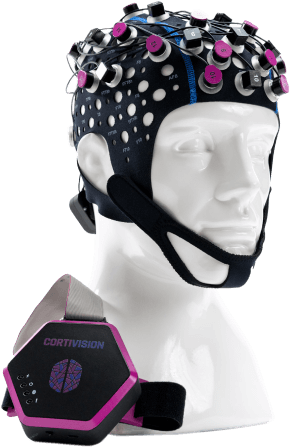For more information or to speak with the
Brain Vision Scientific Consulting Team dial
(877) EEG-4MRI or schedule a call


Brain Vision LLC (US) and Brain Vision Solutions (Canada) are excited to be the exclusive distributors for Cortivision in North America. Cortivision is led by scientists who share our dedication to the research community and they are eager to collaborate with us to ensure that researchers have access to high quality, ultra-compact functional Near-Infrared Spectroscopy (fNIRS) solutions for fNIRS and combined EEG-fNIRS experiments.
The PHOTON CAP fNIRS system weighs about half a pound (less than 230 grams) and can be worn effortlessly on a subject’s arm or chest while collecting data with its set of 16 sources and 10 detectors. Its ultra-compact design was a key factor in its selection for the Axiom-2 mission to the ISS and in Spring of 2023 it became the first fNIRS device used in space
(https://www.cortivision.com/2023/05/first-fnirs-into-space-cortivision-iss-research/)!
With Brain Vision’s experience with fNIRS as well as integrating it with EEG*, we are excited to help more researchers apply Cortivision’s solutions in their studies!
*Brain Vision has experience combining our EEG solutions with fNIRS solutions from Artinis, GowerLabs, Hitachi, NIRx, Shimadzu, TechEn, and more.
The first fNIRS device to be sent to space, the Cortivision PHOTON CAP C20 has impressive specs in a compact package:
Sources
16 LEDS (12x standard, 4x short), 760 and 850nm
Detectors
10 (Silicon Photodiodes)
Standard Channels
Up to 33
Short Distance Channels
Up to 4
Sampling rate
Up to 92 Hz
Battery
6hrs (extendable with USB power bank)
Records
Via wireless communication protocol
Inertial Measurement Unit (IMU)
Integrated into optode bundle (accelerometer & gyroscope)
Size and Weight
5 inch x 5 inch x 2 inch; less than 0.5 pounds
12 cm x 12 cm x 5 cm; less than 230 grams
Hyperscanning
LSL input and output ready
Software
CortiView – Montage Setup and Recording
CortiPrism – Analysis

As a relatively new manufacturer in the fNIRS space, you may not have heard of Cortivision and their PHOTON CAP fNIRS system yet. Cortivision was developed in the past five years by a tight-knit group of friends with years of experience in the neuroscience research, usability, and specifically the fNIRS field. They recognized the potential that fNIRS offers for studying bloodflow in the brain in novel ways without the need for huge, powerful magnets. They set about delivering a portable, powerful, and easy-to-use fNIRS system utilizing Polish and European Union public innovation funding opportunities.
Similar to how functional Magnetic Resonance Imaging (fMRI) measure changes in oxy and deoxy hemoglobin with powerful magnets, functional Near-Infrared Spectroscopy (fNIRS) does a similar measurement with near-infrared light. Oxygenated and de-oxygenated hemoglobin molecules absorb specific wavelengths of near-infrared light at different rates (molar extinction coefficients).
The first fNIRS systems used powerful lasers to generate light at these specific wavelengths. Some systems still do that but this requires heavy fiber optic cables to route the light from the laser to the head. Modern systems now use specially tuned LEDs allowing for light weight sources to be placed on the head.
By shining light at these specific wavelengths into the scalp of a subject, we can measure how much of that light travels via paths into the scalp and through the outer cortex (via diffusion and diffraction along the “photon banana” path). The light that makes it through is quantified and digitized by silicon photodiode detectors (very sensitive photosensors).
The spectroscopic analysis technique allows us to plug these quantities of light using the Modified Beer-Lambert Law to calculate changes in hemoglobin concentration. When neurons in one part of the brain fire more, they have a higher metabolic demand leading to more oxy-hemoglobin being sent to that part of the brain and a decrease in deoxy-hemoglobin. This change in concentrations can happen over the course of a few seconds. Like fMRI experiments, fNIRS experimental design requires setting up contrasting conditions to show relative blood flow changes and this may rely on block designs or more dispersed trials.
For more information or to speak with the
Brain Vision Scientific Consulting Team dial
(877) EEG-4MRI or schedule a call
Billing address:
Brain Vision, LLC
1204 Village Market PL #300
Morrisville, NC 27560
Shipping address:
Brain Vision, LLC
515 N. Greenfield Parkway, Suite 100
Garner, NC 27529
| Cookie | Duration | Description |
|---|---|---|
| cookielawinfo-checkbox-analytics | 11 months | This cookie is set by GDPR Cookie Consent plugin. The cookie is used to store the user consent for the cookies in the category "Analytics". |
| cookielawinfo-checkbox-functional | 11 months | The cookie is set by GDPR cookie consent to record the user consent for the cookies in the category "Functional". |
| cookielawinfo-checkbox-necessary | 11 months | This cookie is set by GDPR Cookie Consent plugin. The cookies is used to store the user consent for the cookies in the category "Necessary". |
| cookielawinfo-checkbox-others | 11 months | This cookie is set by GDPR Cookie Consent plugin. The cookie is used to store the user consent for the cookies in the category "Other. |
| cookielawinfo-checkbox-performance | 11 months | This cookie is set by GDPR Cookie Consent plugin. The cookie is used to store the user consent for the cookies in the category "Performance". |
| viewed_cookie_policy | 11 months | The cookie is set by the GDPR Cookie Consent plugin and is used to store whether or not user has consented to the use of cookies. It does not store any personal data. |
* indicates required fields
"*" indicates required fields
Please select your area to schedule an introductory call with one of our Scientific Consultants.
script here